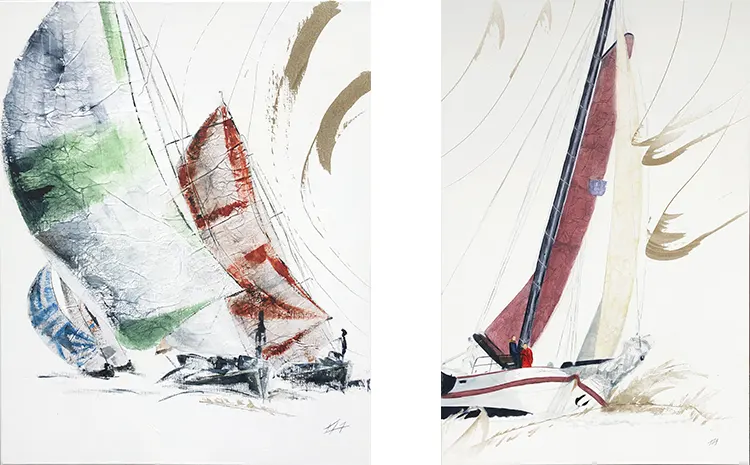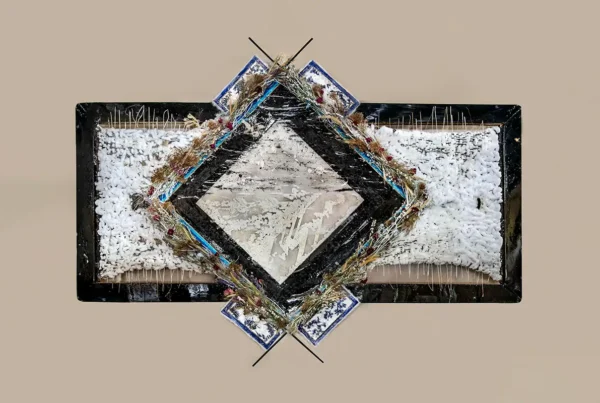“One dream I harbor is to have my own personal workshop where I can fully immerse myself in my creative universe.”
The Early Years: Exploring the World Through Abramatic’s Brushstrokes
Hailing from Eastern France, Alain Abramatic first discovered his affinity for painting amid the region’s picturesque lakes and towering mountains. The local landscapes not only offered ample opportunities for sailing and skiing but also provided the young Abramatic with inspiration for his future masterpieces depicting sailboats and mountainous terrains.
Artistic appreciation ran deep in his lineage, and beauty was held in high esteem within his family circle. He recounts being profoundly affected by Goya’s Saturn during a visit to the Prado Museum in Madrid, a memory that underscores his lifelong love for museum trips.
While maintaining a balance between his professional commitments and his artistic passions, Abramatic managed to organize occasional exhibitions throughout his life. However, as the years drew him closer to retirement, the focus gradually shifted towards devoting a significant part of his time to his artistic pursuits. He is now member of the Arts – Sciences – Lettres academy located in Paris.
Water, an element with a tangible presence in his early life, began to emerge as a recurrent theme in Abramatic’s oeuvre. His explorations stretched beyond lakes to the coasts of Brittany and eventually spanned across multiple global locations. The thrill and tranquillity of these sailing experiences infused his canvas, with sailboats and lighthouses becoming frequent subjects.
From a tender age, Abramatic found himself drawn to the art of sketching, inspired in no small part by his father’s skillful drafts. His introduction to canvas painting happened during his final school year under the mentorship of a painter-cum-visual arts teacher. This revelation of being capable of creating art led him to reinterpret landscapes and express his emotional response towards them. Impressionist and Fauvist painters like Cézanne, Van Gogh, and Vlaminck significantly influenced his early works, where a vibrant palette, along with brush and knife techniques, came into play.
Abramatic’s artistic evolution witnessed a shift from oil painting to watercolor, although he never truly abandoned the former medium. Oil painting, with its versatility, allowed him to manipulate drying times and intensities meticulously, thereby achieving a harmonious interplay between contrast and transparency. On the other hand, the practical considerations that prompted him to delve into watercolors led to an unexpected appreciation for its inherent transparency. Inspired by traditional Chinese painting, Abramatic ingeniously integrated misty planes into his mountain scenes, striving for a minimalist aesthetic that captured the quintessence of his subjects.

Embracing Texture and Gesture: Alain Abramatic’s Medium Experimentations
Two decades prior, Alain Abramatic immersed himself in the world of fine arts, enrolling in an esteemed workshop. Under the instruction of a seasoned Parisian painter, Abramatic rekindled his passion for artistic expression and began to experiment with a multitude of techniques and mediums. His artistic inclinations gravitated towards the tactile engagement of sand and paper collage, allowing him to incorporate an array of textures into his oeuvre. Abramatic faced a unique challenge in returning to pigment; he had to curtail his palette to preserve the simplicity of his work. Concurrently, he shifted towards the utilization of larger canvases, which further afforded him the opportunity for more expansive and expressive gestural work.
Abramatic’s immersion in the workshop catalyzed the frequency of his exhibitions. His masterpiece, “Le rêve de Ferber,” clinched an award and subsequently propelled him towards his inaugural solo exhibition.
The figurative subject matter prevalent in Abramatic’s paintings often draws from reminiscences of his childhood, featuring motifs of sailboats, mountains, and sea-related figures intermingled with musical elements. Despite this figurative narrative, he also instills a graphic and abstract component within his works, encapsulating the essence of the moments he chooses to portray. Abramatic masterfully uses white as a cornerstone in the construction of his paintings, stripping away extraneous details to free his subjects. This white space becomes a canvas within a canvas, teeming with lines of force and abstract textures that he crafts through the adhesion of sand and judicious sprinkling, thus achieving equilibrium within his compositions.
While Abramatic’s color palette remains somewhat consistent, he has gradually transitioned towards a more ethereal aesthetic. By using diluted oil, he imbues his work with a transparency reminiscent of watercolors. The preparatory steps, such as canvas bleaching and paper collage implementation, enhance these sought-after effects.
In his more recent works, Abramatic has ventured into the realm of pure abstraction, in pursuit of fresh artistic stimulation. Guided by Zen anecdotes, he has tapped into a wellspring of emotions that animate his creations. The elements of composition and form have emerged as paramount aspects of his artistic journey. In this return to abstraction, he yearns for liberty in his gestures and use of color. His latest series, inspired by the nuances of the written word, explores various techniques for applying and blending color.

The Sailing Moment: Capturing Energy and Stillness in Abramatic’s Works
The recent works of Alain Abramatic primarily draw inspiration from the dynamic world of sailing, masterfully encapsulating the oscillating sensations of maneuvering amidst wind and waves. Abramatic exercises precision to portray boats with realism, while simultaneously conveying the ebullient energy and liberating movement intrinsic to the sport. His strategic brushstrokes, laid down during the canvas preparation phase, manifest themselves in the final coloring process, subtly shaping the final outcome.
His compositions skillfully use collages to juxtapose figurative and abstract elements, underscoring the enduring solidity of the boat against the formidable forces of nature. The depiction of the sea remains suggestive, rather than explicit, creating a contemplative space that allows the primary subject – the sailing moment captured in time – to command attention.
Abramatic acknowledges the profound influence exerted upon him by masters of Impressionism and Fauvism, including luminaries such as Van Gogh, Cézanne, and de Vlaminck. The resonance of Turner’s work in Abramatic’s own practice is undeniable, possibly catalyzing his admiration for classical Chinese artists like Shitao and Chu Ta, as well as contemporary figures Zao Wou-Ki and He Yifu.
The majority of Abramatic’s artistic endeavors unfold within a communal studio, which he frequents twice a week. The initial stages of his process, including the preparation of the canvas with an initial layer of white, the preliminary sketching, and occasional paper application, are undertaken at home. The shared studio space is reserved for the more expansive stages of glue and sand application. The studio’s small garden provides an ideal setting for shaking off excess material. The coloring process is also conducted in the studio, owing to the inevitable odors produced, though Abramatic has adopted the use of citrus essence as a more pleasing alternative to turpentine over the past three years.
Prior to engaging with the canvas, Abramatic sets up his workspace, arranging palette, brushes, scrapers, rags, color tubes, and a jar of citrus essence. The canvas is then affixed to the easel, and the requisite tools selected. He assesses the adhesion of the paper and the sand gluing, making necessary adjustments. A period of focus follows; Abramatic is blessed with an innate ability to deeply concentrate, unbothered by potential distractions. With colors selected and laid on the palette, he commences. Regular retreats are taken to critically evaluate the evolving work and its direction. Abramatic acknowledges that the completion of a painting often demands multiple sessions, guiding his progression through distinct, well-defined stages.

From Classic Influences to Abstraction: Alain Abramatic’s Artistic Evolution
Boasting a career spanning half a century, Alain Abramatic’s oeuvre presents an array of notable works. The inaugural canvas in his collection portrays an idyllic scene of a boat docked in a port bathed in the glow of a setting sun, the light piercing through a fishing net suspended from the mast. His versatility as an artist is also evidenced in a captivating watercolor composition, featuring mist-enshrouded mountains reminiscent of traditional Chinese painting.
A cherished piece in Abramatic’s repertoire is the portrait of Rostropovitch. In this, he skillfully amalgamates the musician with his instrument, capturing an aura of deep concentration and the very quintessence of music. Abramatic’s painting of the Huangguoshu waterfall resonates with the spirit of classical Chinese art, while his seafaring pieces, notably “Bourrasque,” vividly evoke the sensation of wind and waves.
His artwork titled “Gange-4” brings to life the river’s journey and traditional bathing rituals. This is achieved through the use of Chinese shadow techniques and the delicate artistry of hand-cut collages. Nonetheless, the piece that holds special significance for Abramatic is “Le Rêve de Ferber,” a 2014 masterpiece that garnered an award at an aviation-themed competition. Painted on a sprawling canvas of 70×200 cm dimensions, this creation marked a personal triumph, as it was one of his earliest individual sales, notably to an aviation aficionado.
Among Abramatic’s aspirations is to establish a personal workshop, a sanctuary where he can dive headfirst into his artistic universe. Known for his penchant for serial work, he recently concluded a series of eight lighthouse paintings, each spanning 40 x 80 cm. His current shared workspace, however, has impeded his ability to keep these works within constant view.
At present, Abramatic grapples with the absence of a sufficiently large exhibition space to concurrently display these creations. A few years prior, he undertook a project necessitating the simultaneous crafting of 10 paintings, each measuring 50×70 cm. Conceptualized in the spirit of a Chinese scroll, this series was inspired by ‘The Wisteria Princess’ legend, with each painting capturing an episode from the tale. Despite the challenge of maintaining continuity in this grand horizontal landscape, Abramatic triumphed, with favorable weather allowing him to execute the overarching gesture in his garden. Regrettably, he was restricted to coloring only two canvases at a time, a limitation he hopes to overcome with a larger, personal workspace.






